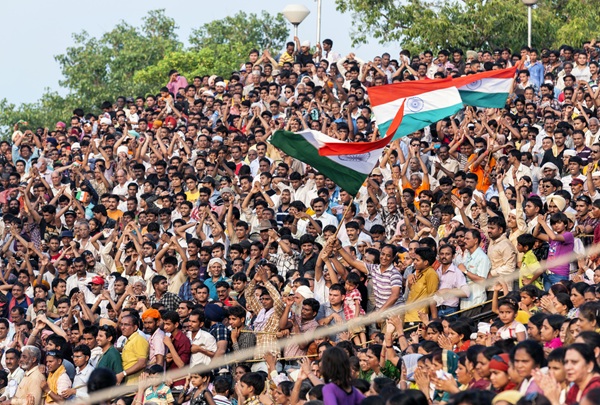.png)
Sangeeta Godbole, a former bureaucrat and trade negotiator, now teaches and researches global trade and environmental issues.
August 20, 2025 at 6:09 AM IST
US President Donald Trump’s recent announcement of a 50% tariff on Indian imports has left the country’s commercial diplomacy and industry facing a stress test. Despite a burgeoning relationship with the Washington, the move came with little warning, and it serves as a reminder that strategic foresight and institutional resilience are key.
The shock, while not entirely unprecedented, appears to have done what bureaucratic delays could not: kickstart long-pending reforms across critical sectors. The Prime Minister’s Office has since rolled out a series of announcements, from semiconductors to nuclear energy and employment schemes, many of which had been stuck in policy pipelines for years.
Any lowering of the danger risks India falling into its usual slow-motion trap.
Pokhran to Sindoor
India is no stranger to external economic coercion.
In 1998, after the Pokhran-II nuclear tests, Western powers, including the US, Japan, Germany, and Australia, imposed sweeping sanctions. Rather than bow, India responded with sweeping reforms, liberalising sectors, launching the National Highway Development Programme, and creating Special Economic Zones.
Now in 2025, India once again finds itself responding to a coercive move, but from a position of far greater strength.
India Building
India’s rise has often occurred despite, not because of, Western cooperation.
During the COVID-19 pandemic, when Western nations hoarded vaccines and withheld critical raw materials, India built its own vaccines, scaled up domestic production, and launched Vaccine Maitri, shipping millions of doses to over 70 countries.
Meanwhile, its digital transformation, powered by India Stack, Aadhaar, and Unified Payments Interface, has become a case study in digital empowerment and sovereignty.
The Unified Payments Interface alone now handles over 10 billion transactions monthly and is being adopted internationally.
This spirit of building what the world won't give, digital infrastructure, vaccines, military capability, or energy security, is at the heart of India's 21st-century story.
Reform Cascade
The Modi government’s recent announcements reflect not only urgency but delayed realisation. While the implementation details are yet to emerge, the announcements reveal a sense of urgency and conviction.
Along with these sweeping and welcome announcements, the test will be to follow up with tangible results on the ground.
Chip-Up
A dormant semiconductor aspiration finally sees traction with the first domestically produced chip set for rollout this year. India’s semiconductor policy has stagnated for over a decade.
Nuclear Power: Tenfold Growth by 2047
India plans to increase nuclear energy capacity tenfold by 2047, with 10 new reactors under construction. Since the 2005 Indo-US nuclear deal, expansion has been repeatedly stalled by regulatory delays and safety debates. Nuclear energy will enhance India’s green manufacturing and improve its contribution to climate action.
GST 2.0 Reform on Diwali
Much excitement has followed the message to unveil next-generation GST reforms during Diwali to ease compliance and cut rates on essentials. Widespread calls for rationalisation from MSMEs and state governments, right since GST was launched, will now be heard and acted upon.
Bharat Reform Task Force
A dedicated task force will be created to fast-track next-generation governance and economic reforms. India’s age-old issue with red tape and ineffective public service delivery is its biggest challenge. Addressing that single concern can unleash a whole wave of growth and development.
Rozgar Yojana
As manufacturing demands greater precision and quality, the natural pivot is towards automation. The real vulnerability for the vast Indian workforce is unemployment. India must address this vulnerability not only by supporting salaries, but also by employing technology that is employment-centric.
Demography Mission
India now recognises demographic imbalance as a strategic and social issue. With some populations already at below replacement rate, India seems to learn from the Japanese and even Chinese predicament to restore its demographic dividend and address the strategic challenges therein.
Ocean Churn
While deep-sea mining has been discussed as early as 2005, these resources may finally enter the energy independence conversation. India is now owning its least explored ocean, much below the surface, too.
Jet Set
A challenge thrown at Indian engineers to end reliance on foreign powers, it may just see the emergence of a super-efficient jet engine built on Indian thrifty nimbleness.
Viksit Bharat
If Trump’s tariff announcement hurts, it will also help fast-track the Viksit Bharat agenda. They remind India that personal diplomacy must be flanked by preparedness and leverage.
However, not only policy makers and enthusiasts, but industry, academia and individual citizens must also participate in this effort to trump Trump.
Let us see a whole of India approach rather than the usual blame game.
Reigniting dormant policy agendas, Trump’s unfair affront of 50% tariffs has sharpened India’s sense of what must be done, and done urgently. I just hope he does not go TACO.
To some destinations, there are no shortcuts. Viksit Bharat is one of them.




